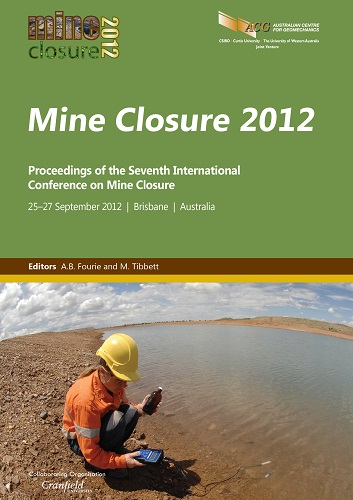The fallacy of designing for in-perpetuity: geotechnical presumptions, ecosystem responses and concepts for managing inevitable change

|
Authors: Fourie, AB; Tibbett, M; De Jong, J |
DOI https://doi.org/10.36487/ACG_rep/1208_13_Fourie
Cite As:
Fourie, AB, Tibbett, M & De Jong, J 2012, 'The fallacy of designing for in-perpetuity: geotechnical presumptions, ecosystem responses and concepts for managing inevitable change', in AB Fourie & M Tibbett (eds), Mine Closure 2012: Proceedings of the Seventh International Conference on Mine Closure, Australian Centre for Geomechanics, Perth, pp. 127-136, https://doi.org/10.36487/ACG_rep/1208_13_Fourie
Abstract:
The design requirement for the performance of covers to tailings storage facilities and waste rock dumps is increasingly being stipulated as being ‘in-perpetuity’. This is often interpreted as being in excess of 1,000 years. There are no other geotechnical systems that have a design life anywhere as long as this. Geotechnical systems such as earth dams, slopes and foundations, which typically have design lives of 50‒70 years, are designed on the basis of engineering properties measured during and immediately after the design and construction process. Implicit in this approach is the assumption that these properties do not change with time. However, in the case of cover systems, a number of ecological factors are likely to cause changes in properties such as hydraulic conductivity, density and strength, with time. We give examples of how the initial geotechnical design assumptions are not stable and will inevitably change as the system evolves. Typically, starting from an inert biologically barren system, through the process of carbon fixation (photosynthesis) and energy capture, the biological, chemical and physical properties of these structures will change. These changes may sometimes be considerable (order of magnitude) and sometimes occur with surprising speed (a few years, not centuries). We go on to consider ways in which harnessing nature and inevitable (eco-)system change might be brought into the planning and design of post-mining landforms. We propose that the days of geotechnical design as the sole concept in mining should evolve into biogeotechnical design, where inevitable change is harnessed to enhance the properties of the new land system, rather than degrade it.
© Copyright 2025, Australian Centre for Geomechanics (ACG), The University of Western Australia. All rights reserved.
View copyright/legal information
Please direct any queries or error reports to repository-acg@uwa.edu.au
View copyright/legal information
Please direct any queries or error reports to repository-acg@uwa.edu.au